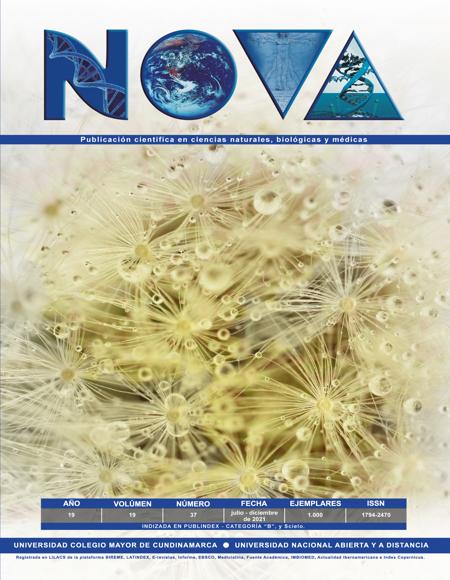Enfermedades hematológicas y no hematológicas relacionadas con el fenotipo ABO en pacientes de una unidad hospitalaria de Medellín.
Hematological and non-hematological diseases related to the ABO phenotype
Mostrar biografía de los autores
Introducción: El sistema sanguíneo ABO está compuesto por los antígenos A y B, los cuales varían de acuerdo a las sustituciones de nucleótidos, que determinan la especificidad de la enzima para la cual codifican. Su importancia clínica se extiende más allá de los procesos transfusionales, aparentemente está involucrado en la fisiopatología de varias enfermedades, como cáncer, infecciones, alteraciones cardiovasculares, entre otras. Metodología: estudio descriptivo retrospectivo, con 2708 datos de clasificación de grupo sanguíneo ABO en pacientes hospitalizados. Se realizó la prueba de Chi2 de independencia para determinar la relación entre enfermedades hematológicas y no hematológicas y el grupo sanguíneo. Resultados: El grupo sanguíneo O se presentó en el 59,2% y el AB en el 18% de los pacientes; las entidades clínicas que predominaron fueron las no hematológicas; entre ellas las más frecuentes la hemorragia gastrointestinal, diabetes mellitus y las fracturas tanto para el grupo A como el B. En el grupo AB se presentó la tuberculosis y hemorragia gastrointestinal. Para las enfermedades de la sangre y de los órganos hematopoyéticos, en los grupos sanguíneos A, AB y O predominó la anemia de tipo no especificada, por su parte en el grupo B se presentó la anemia falciforme en crisis. Conclusión: en el presente estudio no se pudo establecer desde el análisis estadístico la relación entre los antígenos de grupo sanguíneo y el desarrollo de una entidad clínica en particular, pero desde el punto de vista clínico si se pudo notar la tendencia de una frecuencia más alta de una enfermedad en un grupo sanguíneo específico.
Visitas del artículo 352 | Visitas PDF 270
Descargas
REFERENCIAS BIBLIOGRÁFICAS
1. González-Ordóñez ÁJ. Grupos sanguíneos y enfermedad. Med Clin (Barc) [Internet]. 2005;125(10):382–8. Available from: http://dx.doi.org/10.1157/13079179
2. Anstee DJ. The relationship between blood groups and disease. Blood. 2010;115(23):4635–43. Available from: https://doi.org/10.1182/blood-2010-01-261859
3. Arbeláez- García C. Sistema de grupo sanguineo ABO. Med Lab [Internet]. 2009;15(7):329–47. Available from: Available from: https://www.medigraphic.com/pdfs/medlab/myl-2009/myl097-8c.pdf.
4. Franchini, Massimo and Liumbruno GM. “ABO blood group: old dogma, new perspectives.” Clin Chem Lab Med. 2013;51(8):1545–53. Available from: https://pubmed.ncbi.nlm.nih.gov/23648637/DOI: 10.1515/cclm-2013-0168
5. Zhang H, Mooney CJ, Reilly MP. ABO blood groups and cardiovascular diseases. Int J Vasc Med. 2012;2012. Available from: https://pubmed.ncbi.nlm.nih.gov/23133757/ DOI: 10.1155/2012/641917
6. Edgren G, Hjalgrim H, Rostgaard K, Norda R, Wikman A, Melbye M, et al. Risk of gastric cancer and peptic ulcers in relation to ABO blood type: A cohort study. Am J Epidemiol. 2010;172(11):1280–5. Available from: https://pubmed.ncbi.nlm.nih.gov/20937632/ DOI: 10.1093/aje/kwq299
7. Wolpin BM, Chan AT, Hartge P, Chanock SJ, Kraft P, Hunter DJ, et al. ABO blood group and the risk of pancreatic cancer. J Natl Cancer Inst. 2009;101(6):424–31. Available from:https://pubmed.ncbi.nlm.nih.gov/19276450/ DOI: 10.1093/jnci/djp020
8. JAIME C-F. Frecuencia de los grupos sanguíneos ABO y Rh en la población laboral del valle de Aburrá y del cercano oriente de Antioquia (Colombia). Acta Médica Colomb [Internet]. 2006;31(1):20–30. Available from: https://www.redalyc.org/pdf/1631/163114147009.pdf
9. Del Peón-Hidalgo L, Pacheco-Cano MG, Zavala-Ruiz M, Madueño-López A, García-Gonzáles A. Frecuencias de grupos sanguíneos e incompatibilidades ABO y, RhD, en La Paz, Baja California Sur, México. Salud Publica Mex. 2002;44(5):406–12. Available from:http://www.insp.mx/salud/index.html
10. Pérez Escobar, Rocío, Betancur Ceballos, Carolina, López Mendoza, Andrea, Saavedra Perea, Juana, Ríos Osorio L. Frecuencia de los principales grupos sanguíneos del sistema ABO y el factor Rh en seis municipios del área rural del departamento de Antioquia y el Atrato Medio, Colombia, 2005. Hechos Microbiol. 2010;1(2):27–33. Available from: https://revistas.udea.edu.co/index.php/hm/article/view/9548
11. Fagherazzi G, Gusto G, Clavel-Chapelon F, Balkau B, Bonnet F. ABO and Rhesus blood groups and risk of type 2 diabetes: evidence from the large E3N cohort study. Diabetologia. 2015;58(3):519–22. Available from: https://pubmed.ncbi.nlm.nih.gov/25533388/ DOI: 10.1007/s00125-014-3472-9
12. Huidobro Muñoz A, Torres C. D, Paredes F. Diabetes Gestacional: Asociación con grupo ABO. Rev Med Chil. 2017;145(4):431–5. Available from:http://dx.doi.org/10.4067/S0034-98872017000400002
13. Li X, Xu H, Gao P. ABO Blood Group and Diabetes Mellitus Influence the Risk for Pancreatic Cancer in a Population from China. 2018;9392–8. Available from: https://www.ncbi.nlm.nih.gov/pmc/articles/PMC6320638/doi: 10.12659/MSM.913769
14. Biswas S, Ghoshal PK, Halder B, Mandal N. Distribution of ABO blood group and major cardiovascular risk factors with coronary heart disease. Biomed Res Int. 2013;2013. Available from: https://doi.org/10.1155/2013/782941
15. Vasan SK, Rostgaard K, Majeed A, Ullum H, Titlestad KE, Pedersen OBV, et al. ABO Blood Group and Risk of Thromboembolic and Arterial Disease: A Study of 1.5 Million Blood Donors. Circulation. 2016;133(15):1449–57. Available from:DOI: 10.1161/CIRCULATIONAHA.115.017563
16. Franchini M, Lippi G. The intriguing relationship between the ABO blood group, cardiovascular disease, and cancer. BMC Med. 2015;13(1):1–3. Available from: DOI https://doi.org/10.1186/s12916-014-0250-y
17. Chowdhary S, Sharma V, Chowdhary S. Study of association of ABO blood group with ischemic heart disease. Int J Med Sci Public Heal. 2016;5(3):468. Available from doi: 10.5455/ijmsph.2016.0408201584
18. Li Y, Liu L, Huang Y, Zheng H, Li L. Association of ABO polymorphisms and pancreatic Cancer/ Cardiocerebrovascular disease: A meta-Analysis. BMC Med Genet. 2020;21(1):1–10. Available from: doi: 10.1186/s12881-020-0975-8
19. Tanaka Y, Kumagi T, Terao T, Kuroda T, Yokota T, Yukimoto A, et al. ABO Blood Type and the Long-term Outcomes of Pancreatic Cancer. 2020;761–8. Available from: doi: 10.2169/internalmedicine.3748-19
20. Nakao M, Matsuo K, Ito H, Shitara K, Hosono S, Watanabe M. ABO Genotype and the Risk of Gastric Cancer , Atrophic Gastritis , and Helicobacter pylori Infection. 2011;1665–73. Available from:DOI: 10.1158/1055-9965.EPI-11-0213
21. Chakrani Z, Robinson K, Taye B. Association Between ABO Blood Groups and Helicobacter pylori Infection: A Meta-Analysis. Sci Rep [Internet]. 2018;8(1):1–11. Available from: http://dx.doi.org/10.1038/s41598-018-36006-x
22. Press D. Relation between ABO blood groups and Helicobacter pylori infection in symptomatic patients. 2011;221–6. Available from: https://www.ncbi.nlm.nih.gov/pmc/articles/PMC3190290/ doi: 10.2147/CEG.S23019
23. Lawrence Tim Goodnough, MDa B, Anil K. Panigrahi, MD, PhDa C. Blood Transfusion Therapy. Med Clin North Am. 2017;101(2):431–47. Available from: https://pubmed.ncbi.nlm.nih.gov/28189180/ DOI: 10.1016/j.mcna.2016.09.012
24. Quintero M, M.D. Jimenez M. Anemia de celulas falciformes m. Rev Gastrohnup. 2012;14(2):27–35. Available from: https://revgastrohnup.univalle.edu.co/a12v14n2s1/a12v14n2s1art4.pdf
25. Salomón-Cruz J, Gómez-Valencia L, Morales-Hernández A. Estudio clínico y genético de tres casos de anemia de células falciformes. Salud en Tabasco. 2006;12(2):440–2. Available from: https://www.redalyc.org/pdf/487/48712206.pdf
26. Fong C, Menzel S, Lizarralde MA, Barreto G. Genetic variants associated with fetal hemoglobin levels show the diverse ethnic origin in Colombian patients with sickle cell anemia. Biomedica. 2015;35(3):437–43. Available from: http://dx.doi.org/10.7705/biomedica.v35i3.2573
27. Pelcovits A, Niroula R. Acute Myeloid Leukemia: A Review. R I Med J (2013) [Internet]. 2020;103(3):38–40. Available from: http://www.ncbi.nlm.nih.gov/pubmed/32236160
28. De Kouchkovsky I, Abdul-Hay M. ‘Acute myeloid leukemia: A comprehensive review and 2016 update.’ Blood Cancer J. 2016;6(7). Available from: https://pubmed.ncbi.nlm.nih.gov/27367478/doi: 10.1038/bcj.2016.50.









